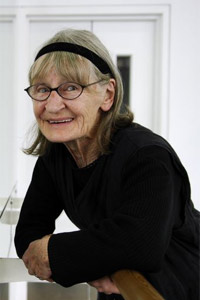KELLY APTER
IT’S A hot, humid afternoon in West London, and

is reminiscing. Every available shelf and wall space in her living room is covered with theatrical memorabilia, each one with a story attached. Suddenly, the clouds unleash a torrent of rain and Payne-Myers jumps to her feet. „My washing,“ she cries, climbing on to a table and leaping out of the window, on to a small roof terrace. Moments later she reappears, clutching an armful of laundry, and hops nimbly back into the room. None of which would be remotely exceptional, but for the fact that Payne-Myers will be 80 next March.
There aren’t many octogenarians who can boast the agility of a cat – but then Payne-Myers is unique in many ways. As a dancer and actress, she has had a career spanning 60 years, and it’s not over yet. About to make her Edinburgh Fringe debut in Muscular Memory Lane, a duet with choreographer, Matthew Hawkins, Payne-Myers has scant regard for the word „retirement“. „People assume I’ve retired,“ she says. „But once a dancer, always a dancer. Just like a painter or singer, you’ll always paint or sing and keep creating.“
As she runs through her mental book of memories, peppering each chapter with vivid images, it’s clear that Payne-Myers has led an extraordinary life. Born in Darlington in 1928 to Scottish parents (a surgeon father from Stornoway and teacher mother from Ayrshire) Payne-Myers started dancing aged six. „My ballet teacher would give lessons to the young Princesses Elizabeth and Margaret during the week, then teach us at the weekend,“ she recalls. „I remember being quite proud of that.“
Growing up during the Second World War, a career in dancing seemed impossible, so Payne-Myers headed for secretarial college. But a move to London turned her head sufficiently. „We went dancing in nightclubs every night, and it was such fun that I thought there must be more to life than being a secretary,“ she says. „Then I met a girl who danced with Rambert and she told me that, at 20, I wasn’t too old to become a dancer.“ Accepted into both the Rambert school and company, Payne-Myers embarked on a diverse career that would encompass ballet, contemporary dance, performance art and West End musicals.
In the 1950s she was a jazz dancer on the ITV programme, Cool for Cats – a predecessor to Top of the Pops. She also spent three weeks at the Pavilion in Glasgow, performing alongside Dean Martin and Jerry Lewis. More recently, she has performed with English National Opera and DV8. Nothing, it would seem, fazes this exceptional lady – as DV8’s 2003 show, Living Costs, at Tate Modern ably proved.
Asked by DV8 director, Lloyd Newson, to sit naked in the gallery next to a sign saying „please touch“, Payne-Myers didn’t bat an eyelid – literally. „I had to sit completely still,“ she says. „People touched me if they wanted to, and each touch and caress was so respectful. But then one night, a young man stuck his finger up my nose, which I thought was horrible – but I remained still.“
Given her propensity to move almost constantly, it’s hard to imagine Payne-Myers in a state of stillness. Throughout our time together, she never stops – jumping up to perform a graceful ballet move or dig out an old theatre programme – often with a cigarette in her hand. Like many dancers, Payne-Myers has smoked all her life, with seemingly no repercussions. Sadly, her husband’s constitution was less strong. Her marriage to writer Peter Myers (the man behind Cliff Richard’s 1960s films, The Young Ones and Summer Holiday) ended in 1978, when he died of diabetes, aged 55.
Payne-Myers has never remarried, ploughing her efforts into her career and two children – one of whom was responsible for her return to the stage after a long absence.
„My son became a dancer and was right in the middle of the dance world,“ she says. „So I was back meeting friends I hadn’t seen for years, and being asked to do things. I became accepted by a different generation, and because I was healthy and loved dancing I’ve continued doing it. Dancing is good for me, it makes me happy.“
Her Fringe show with Hawkins was devised for exactly that purpose – to keep her in good mental health. Muscular Memory Lane uses Hawkins’s special choreographic style, which helps keep the mind focused. „Diana was interested in what this project would do for her mind, in terms of stitching it together a bit,“ explains Hawkins. „She feels as if she’s going a bit batty – but aren’t we all? The choreographic methods I use trigger memory and help with areas of cognition which dancers are in touch with, because they need to remember combinations.“
For Payne-Myers, attending ballet class each morning, and involving herself in one interesting project after another, has clearly kept her young. As for those who choose to work with her, the appeal is obvious. „She’s just a very enthused and super-charged person with a great deal of effervescence,“ says Hawkins. „And that’s why any choreographer at any time would be delighted to have her in their ensemble, because it’s great to have somebody who is a bundle of energy.“
• Muscular Memory Lane in Dance Base presents… TIMELESS is at Dance Base, 8-18 August.
This article:
http://www.scotsman.com/?id=1225922007
Edinburgh Festival Fringe:
http://www.edinburgh-festivals.com/topics.cfm?tid=933
Web links:
Edinburgh Festival Fringe
http://www.edinburgh-festivals.com/fringe/
Вашият коментар